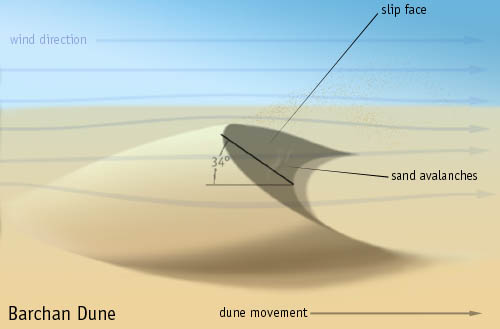
Barchan
Encyclopedia


Dune
In physical geography, a dune is a hill of sand built by wind. Dunes occur in different forms and sizes, formed by interaction with the wind. Most kinds of dunes are longer on the windward side where the sand is pushed up the dune and have a shorter "slip face" in the lee of the wind...
, also barkhan is an arc-shaped sand ridge, comprising well-sorted sand. This type of dune possesses two "horns" that face downwind, with the slip face (the downwind slope) at the angle of repose
Angle of repose
The angle of repose or, more precisely, the critical angle of repose, of a granular material is the steepest angle of descent or dip of the slope relative to the horizontal plane when material on the slope face is on the verge of sliding. This angle is in the range 0°–90°.When bulk granular...
of sand, or approximately 35 degrees (Strahler & Archibold, 2008, pg.442). The upwind side is packed by the wind, and stands at about 15 degrees. Simple barchan dunes may stretch from meters to a hundred meters or so between the tips of the horns. The word is of Turkic origin, borrowed into English via Russian.
Simple barchan dunes may appear as larger, compound barchan or megabarchan dunes, which may migrate with the wind. Barchans and megabarchans may coalesce into ridges that extend for hundreds of kilometers.
As barchan dunes migrate, smaller dunes outpace larger dunes, bumping into the rear of the larger dune and eventually appear to punch through the large dune to appear on the other side. The process seems to be similar to waves of light, sound or water that pass directly through each other; the detailed mechanism is, however, very different, being nonlinear. These are known as soliton
Soliton
In mathematics and physics, a soliton is a self-reinforcing solitary wave that maintains its shape while it travels at constant speed. Solitons are caused by a cancellation of nonlinear and dispersive effects in the medium...
s.
The dunes emulate soliton behavior but unlike solitons, the sand particles do not pass through each other. When the smaller dune rear-ends the larger dune, the winds begin to deposit sand on the rear dune while blowing sand off the front dune without replenishing it. Eventually, the rear dune has assumed dimensions similar to the former front dune which has now become a smaller, faster moving dune that pulls away with the wind. (Schwämmle & Herrmann, 2003)
Fine examples of barchan dunes are found near La Joya
La Joya District
La Joya District is one of twenty-nine districts of the province Arequipa in Peru.-References:...
, Arequipa
Arequipa Province
Arequipa is a province in the Arequipa Region, Peru. It is the most populous province of the region, and its capital, Arequipa, is Peru's second-largest city...
, Peru
Peru
Peru , officially the Republic of Peru , is a country in western South America. It is bordered on the north by Ecuador and Colombia, on the east by Brazil, on the southeast by Bolivia, on the south by Chile, and on the west by the Pacific Ocean....
(16.714564°N 71.834083°W); a number of dunes are readily visible from the Pan American Highway at the intersection with the Carretera Interoceanica just north of La Joya, where they can be seen passing over cement block buildings. In mid-2010, several smaller barchan dunes are approaching the Carretera from the south. These gray-colored dunes are formed from fine-grained volcanic ash from the Huaynaputina
Huaynaputina
Huaynaputina is a stratovolcano located in a volcanic upland in southern Peru. The volcano does not have an identifiable mountain profile, but instead has the form of a large volcanic crater. It has produced high-potassium andesite and dacite...
eruption in 1600.
The Great Sand Dunes National Park in the American
United States
The United States of America is a federal constitutional republic comprising fifty states and a federal district...
state of Colorado
Colorado
Colorado is a U.S. state that encompasses much of the Rocky Mountains as well as the northeastern portion of the Colorado Plateau and the western edge of the Great Plains...
has spectacular examples of barchan dunes.
Barchan dunes have been observed to exist on Mars
Mars
Mars is the fourth planet from the Sun in the Solar System. The planet is named after the Roman god of war, Mars. It is often described as the "Red Planet", as the iron oxide prevalent on its surface gives it a reddish appearance...
, where the thin atmosphere often produces fierce winds, strong enough to move sand and dust.
External links
- Barchan Dunes - Great Sand Dunes National Park
- Bibliography of Aeolian Research

